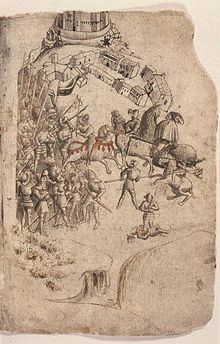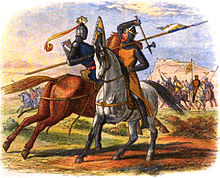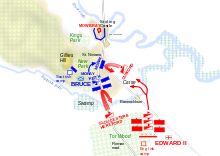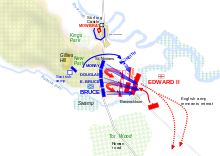Battle of Bannockburn
Battle of Bannockburn
Part of: Scottish Wars of Independence
,_f.40_-_BL_Add_MS_47682.jpg)
Depiction of the Battle of Bannockburn from the Holkham Bible, 1327-1335 (above, the lower half shows the Battle of Berwick in 1318).
Scottish Wars of Independence (1296-1357)
Battles of the First Scottish War of IndependenceBerwick
- Dunbar - Stirling Bridge - Falkirk - Roslin - Stirling Castle - Methven - Dalry - Glen Trool - Loudoun Hill - Inverurie - Brander - Perth - Bannockburn - Berwick - Berwick - Myton - Byland - Weardale
Battles of the Second Scottish War of IndependenceKinghorn
- Dupplin Moor - Annan - Berwick - Halidon Hill - Boroughmuir - Culblean - Neville's Cross
The Battle of Bannockburn on 23-24 June 1314 was one of the decisive battles in the Scottish Wars of Independence of the late 13th and 14th centuries. In the marshes of Bannockburn, near Stirling, the Scottish army led by Robert (the) Bruce won a decisive victory against a considerably larger English army under Edward II.
Previous story
In the spring of 1314 Stirling Castle, which had been under English suzerainty since 1304, was besieged by a Scottish army. When the situation seemed hopeless for the English garrison, the commander Sir Philip Mowbray decided to hand over the strategically important fortress to the Scottish commander if no English relief army arrived by the end of June. The English King Edward II now saw an opportunity to bring the Scottish army to a decisive fight for the besieged castle. He had succeeded in making a peace with the English noble opposition, the Lords Ordainers. This gave him the backing for a campaign to relieve Stirling Castle, to which he called on his vassals in May 1314.
The English Army
Despite peace with the king, a number of barons, including four of the nine English earls, stayed away from the campaign. Most conspicuous was the absence of Thomas of Lancaster, 2nd Earl of Lancaster, who was one of the leaders of the Lords Ordainers, as were the Earl of Warwick and the Earl of Arundel. On the other hand, Aymer de Valence, 2nd Earl of Pembroke, Gilbert de Clare, 7th Earl of Gloucester and Humphrey de Bohun, 4th Earl of Hereford, all three of whom had also been among the Lords Ordainers, took part in the campaign. The exact size of the English army is not known. The King had requested 20,000 foot soldiers, but it is unclear whether this number was actually reached. Accounts of pay have not survived, presumably they were never created because of the hasty flight after the defeat. Nevertheless, despite the absence of Lancaster and the other magnates, the army was one of the largest raised during Edward II's reign. The army included not only English contingents but also Welsh troops, including 2263 infantry under John Charlton, and probably Irish troops as well as soldiers from Gascony, which was then part of England, and a small number of foreign mercenaries. The English army, which had massed at Berwick-upon-Tweed, greatly outnumbered the Scots. On 17 or 18 June 1314 it crossed the border at Coldstream and then turned towards Stirling. By Sunday 23 June 1314 the English force had reached the ford at Bannockburn a few miles south of Stirling, where the Scottish army under the command of Robert Bruce had taken up a position.
The Scottish Army
The Scottish army was about 5000 strong. Like King Edward II, Robert the Bruce was not without controversy as king. He was considered by many Scots to be a murderous usurper to the throne because of the assassination of John Comyn. Comyn's son John fought on the English side, as did the Earl of Angus, who as Lord of Prudhoe and Redesdale also had holdings in northern England. In contrast, the clan of MacDonalds of Islay under Angus Og had joined the Scottish army despite a clan dispute with Robert the Bruce. In all, members of 21 clans fought in the Scottish army. Relying on the Scottish Schiltron formation, the Scottish soldiers intended to fight at close range, thus reducing the superiority of the English heavy cavalry. Among historians, the theory that Robert Bruce was sided by knights of the Order of the Temple who had fled France to seek refuge in Scotland is highly controversial.

The oldest known depiction of the battle from the 1440s
The battle
The battle itself took place in an area a few kilometres wide between the rivers Bannock Burn and Forth. It lasted two days, and although the first clashes were rather insignificant compared to the encounter of the two armies on the second day, there was much to be said for a positive outcome of the battle for the Scots due to the strategically extremely unfavourable position of the positions of the English forces, which were extremely limited in their manoeuvrability in the marshy area between the two rivers Bannock and Pelstream and the bank of the river Forth.
First day (23 June)
First the English sent a mounted force under Sir Robert de Clifford and Sir Henry de Beaumont to the besieged castle. They met a small part of the Scottish infantry force. The Scottish schiltrons again proved their worth and the English attacks were repulsed with little loss, forcing the English cavalry to retreat. At the same time there were a number of minor skirmishes around the core force as some English soldiers crossed the Bannock to confront the Scottish troops. The battle between the English knight Henry de Bohun (a nephew of the Earl of Hereford) and Robert the Bruce survives: De Bohun had spotted Bruce on a pony in front of the Scottish battle line, put on his lance and rode towards the single combatant. At the last moment the pony dodged the onrushing warhorse, at which point Bruce managed to strike a blow at De Bohun's helmet with his battle axe, splitting the latter's skull. When, after some more insignificant skirmishing, the evening dawned, the English army retired to make camp between Bannock and Pelstream.
Demoralized by this defeat, the English spent the night under arms for fear of a Scottish attack. Alexander Seton, a Scottish defector from the English army, is said to have informed Robert Bruce of the uncertainty of the English. Faced with the strength of the English army, Bruce at first wanted to retreat across the Forth, but then decided to take up the fight. When at daybreak the English realised that the Scots had not retreated, the more experienced barons, as well as the young Earl of Gloucester, suggested that the battle should not begin until the next day, so that the army, exhausted by the march, could recover. This advice was rejected by younger barons as cowardice, and the king joined in their opinion and ordered the attack. Bruce also attacked in his turn.
Second day (24 June)
The English army advanced across the Bannock while the Scottish army waited posted at Schiltrons. The initial English cavalry charge was disorganized and resulted in casualties. The Scots, following the example of the Flemings who had defeated the French knights at the Battle of Courtrai in 1302, fought on foot. The tightly closed Scottish schiltrons could not be defeated by the English, while the Scottish spearmen attacked and killed the English horses. The Scottish force then advanced, forcing the cavalry back into the ranks of the English infantry, who were still trying to get to the cavalry across the Bannock.
King Edward II fought bravely in person, but proved to be an incompetent general. He failed to exploit his numerical superiority. He had failed to cover his archers with infantry, and when they tried to enter the battle and began firing arrows at the advancing Scottish infantry, they suffered heavy casualties from a counterattack by the numerically small Scottish cavalry under Robert Keith. To this end, Edward II failed to keep his barons under control. A dispute arose between the young Earl of Gloucester and the Earl of Hereford over the command of the vanguard. The Earl of Gloucester, still aggrieved at the rejection by the king in the morning, is said to have ridden alone ahead of his troops towards the Scottish line and was killed.
On the narrow battlefield, English numerical superiority nullified any attempt to rally their own troops, while the Scottish forces pushed the crowds back towards the river. Hundreds of Englishmen drowned or were trampled by their own retreating men as the English order of battle disintegrated. Edward II was led off the battlefield in time by Henry de Beaumont and, when denied entry to Stirling Castle, fled via Winchburgh to Dunbar Castle and eventually back to England by ship.
Losses
The exact number of English casualties cannot be determined, yet the battle is considered one of the worst defeats ever suffered by an English army on the battlefield. Thousands of English foot soldiers were cut down during the rout. The English troop fell into the hands of the Scots. The most prominent casualty was the Earl of Gloucester. He was among the richest barons in England and was a brother-in-law of Robert the Bruce, who had his body recovered and brought to England for burial. Other victims included Robert de Clifford, Miles Stapleton, 1st Baron Stapleton, William de Vescy of Kildare, John Comyn and Edmund Mauley, Steward of the Household.
Numerous English barons fell into Scottish captivity and were only released in exchange for large ransoms. Among the prisoners were Ralph de Monthermer, the Earl of Gloucester's stepfather, and the Lord Privy Seal Keeper Roger Northburgh, who was taken prisoner along with the royal private seal. The Earl of Hereford fled with the Earl of Angus and his brother Ingram de Umfraville, and with Anthony Lucy to Carlisle, where they took refuge in Bothwell Castle. However, the commander of the castle, a native of Scotland named Walter fitz Gilbert, defected to the Scots and surrendered the castle along with his guests.
As a result of the battle, the garrison of Stirling Castle also had to surrender to the Scots.

Robert the Bruce kills Henry Bohun in a duel. Historicizing depiction from 1864

Map of the Battle of June 23 (First Day)

Map of the Battle of June 24 (Second Day)
Questions and Answers
Q: When was the Battle of Bannockburn fought?
A: The Battle of Bannockburn was fought on 23 and 24 June 1314.
Q: What was the outcome of the Battle of Bannockburn?
A: The Battle of Bannockburn was an important Scottish victory in the Wars of Scottish Independence, where a smaller Scottish army defeated a much larger and better armed English army.
Q: Who won the Battle of Bannockburn?
A: The Scottish army won the Battle of Bannockburn.
Q: How significant was the Battle of Bannockburn in Scottish history?
A: The Battle of Bannockburn was a significant victory in Scottish history, as it marked a turning point in the Wars of Scottish Independence.
Q: What was the size comparison of the Scottish and English armies in the Battle of Bannockburn?
A: The Scottish army was smaller than the English army, despite this they were able to defeat the English.
Q: When did the Wars of Scottish Independence take place?
A: The Wars of Scottish Independence took place in the late 13th and early 14th centuries.
Q: Why was the Battle of Bannockburn important for Scottish independence?
A: The Battle of Bannockburn was important for Scottish independence because it marked a significant victory over a much larger and better armed English army, which allowed Scotland to maintain its independence from England.
Search within the encyclopedia